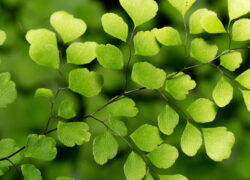Ideal Position
Common Maidenhair Fern is suited to dense, mixed gardens and needs some protection from intense afternoon sun or strong winds. For best results, place it were it receives afternoon shade and is screened from southwesterly winds.
Common Maidenhair Fern is ideal for dampland gardens and for fringing around ponds.
Common Maidenhair Fern is ideally placed at the front of your garden bed.
When to Plant and Watering
Plant young seedlings in Djeran (mid-Autumn) prior to the Makuru rains (Winter). Avoid planting in the hottest times of the year.
Seedlings should be watered twice a week over their first summer in the garden. It is important to ensure water penetrates down into the root-zone.
We recommend using a soil wetting agent as Perth soils are often ‘water repellent’, or do not absorb water effectively.
A layer of composted, coarse mulch can help in getting your garden started. It will help by reducing water loss and suppressing the growth of weeds.
Common Maidenhair Fern should be planted in a moist position.
Artificial dampland gardens should be topped up regularly during dry weather to ensure adequate moisture is available, but not so frequently that they become waterlogged.
Common Maidenhair Fern should be grouped with other dampland plants.
Feeding and Soil Care
Common Maidenhair Fern don’t need fertiliser because they are adapted to grow in our local soils, which are typically low in nutrients.
Plants will benefit from adding some vegetable-based compost (avoid those with manure) into the soil at planting.
As your garden develops, practice ‘cut and drop’ when you prune your plants. The leaf and branch material that falls to the ground slowly breaks down over time, releasing nutrients to help your garden to grow.
How to Prune
Common Maidenhair Fern generally don’t need pruning for shape, as their natural growth is usually attractive and/or interesting.
If part of the plant dies or grows in an undesired direction, prune from the base of the stem in question with a pair of secateurs or loppers.
You can also leave dead leaves and branches on the plant, as they provide valuable habitat and camouflage for insects.








